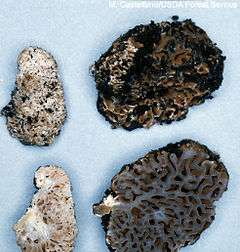Gautieria
Gautieria is a genus of hypogeal fungi in the family Gomphaceae. They form mycorrhizae with various tree species, mostly from the family Pinaceae. Species are present over much of the world's temperate and boreal forest habitats. It is well documented that species from this genera are an important part of the diet of the northern flying squirrel (Glaucomys sabrinus).[3][4][5] Also, some Australian marsupials, especially the rat-kangaroos, feed extensively on these fungi.[6] The fungi also benefit from this relationship: not only do the squirrels help to disperse the spores and propagate the species, studies suggest that passage through the digestive tract of a mammal promotes germination of spores.[7]
| Gautieria | |
|---|---|
 | |
| Gautieria magnicellaris | |
| Scientific classification | |
| Kingdom: | |
| Division: | |
| Class: | |
| Order: | |
| Family: | |
| Genus: | Gautieria Vittad. (1831) |
| Type species | |
| Gautieria morchelliformis Vittad. (1831) | |
| Synonyms[1] | |
Taxonomy
The genus was first described by Italian doctor and naturalist Carlo Vittadini in 1831.[8] for hypogeous (below-ground) gasteromycetes with chambers exposed to the surface and lined with a spore-bearing hymenium, a basal rhizomorph, and ovoid-fusiform, striate-grooved spores. Vittadini's original concept was based on two species he collected in Italy, Gauteria morchellaeformis and Gautieria graveolens. In 1918, Zeller and Dodge examined various dried herbarium collections of Gautieria, and recognized five species.[9] Additional research led to them recognizing 34 species and expanding their generic concept to include species with a well-developed peridium of periclinal hyphae at maturity.[10] As of 2008, Gautieria is thought to contain 25 species.[11]
Description
Fruit bodies (gasterocarps) are typically roughly spherical in shape, with a persisting single or branched rhizomorph. The columella (the central sterile portion of the sporangium) are variable in size and shape. The peridium (the wall of the sporangium) is thin and short-lasting. The gleba is initially white, but later becomes colored by the masses of spores. The basidia are club-shaped, usually two-spored, and with long filiform sterigmata.[9] Spores are 12–26 µm long, and ovoid to ellipsoid in shape.[12]
Species
- Gautieria caudata (Harkn.) Zeller & C.W.Dodge (1934)
- Gautieria chengdensis J.Z.Ying (1984)
- Gautieria chilensis Zeller & C.W.Dodge (1934)
- Gautieria clelandii G.Cunn. (1941)
- Gautieria costata G.Cunn. (1938)
- Gautieria crispa E.L.Stewart & Trappe (1984)
- Gautieria drummondii Cooke (1892)
- Gautieria fuegiana E. Horak (1964)
- Gautieria gautierioides (Lloyd) Zeller & C.W.Dodge (1934)
- Gautieria graveolens Vittad. (1831)
- Gautieria graveolens f. graveolens Vittad. (1831)
- Gautieria graveolens f. inodora A.H.Sm. & Solheim (1953)
- Gautieria graveolens var. graveolens Vittad. (1831)
- Gautieria harknessii Zeller & C.W.Dodge (1934)
- Gautieria inapire Palfner & E.Horak (2001)
- Gautieria macrospora G.Cunn. (1935)
- Gautieria magnicellaris (Pilát) E.L.Stewart & Trappe (1992)
- Gautieria mexicana (E.Fisch.) Zeller & C.W.Dodge (1934)
- Gautieria microspora Rodway (1929)
- Gautieria monospora G.W.Beaton, Pegler & T.W.K.Young (1985)
- Gautieria monticola Harkn. (1884)
- Gautieria morchelliformis Vittad. (1831)
- Gautieria morchelliformis var. globispora Pilát (1958)
- Gautieria morchelliformis var. magnicellaris Pilát (1953)
- Gautieria morchelliformis var. microspora Wichanský (1962)
- Gautieria morchelliformis var. morchelliformis Vittad. (1831)
- Gautieria morchelliformis var. stenospora Pilát (1958)
- Gautieria novae-zelandiae G. Cunn. (1938)
- Gautieria otthii Trog (1857)
- Gautieria pallida Harkn. (1934)
- Gautieria parksiana Zeller & C.W.Dodge (1922)
- Gautieria plumbea Zeller & C.W.Dodge (1918)
- Gautieria pseudovestita Malençon (1976)
- Gautieria queenslandica J.W.Cribb (1958)
- Gautieria retirugosa Fr. (1909)
- Gautieria sinensis J.Z.Ying (1995)
- Gautieria tasmanica Rodway (1929)
- Gautieria tasmanica G.Cunn. (1938)
- Gautieria trabutii (Chatin) Pat. (1897)
- Gautieria villosa Quél. (1878)
- Gautieria xinjiangensis[13]
References
- "Gautieria Vittad., Monographia Tuberacearum: 25, 1831". MycoBank. International Mycological Association. Retrieved 2013-09-01.
- Corda ACJ. (1831). Deutschlands Flora, Abt. III. Die Pilze Deutschlands (in German). 3–11. Nürnberg: Sturm. p. 5.
- Wheatley M. (2007). "Fungi in summer diets of northern flying squirrels (Glaucomys sabrinus) within managed forests of western Alberta, Canada". Northwest Science. 81 (4): 265–73. doi:10.3955/0029-344x-81.4.265.
- Gomez DM, Anthony RG (2005). "Influence of thinning of Douglas-fir forests on population parameters and diet of northern flying squirrels". Journal of Wildlife Management. 69 (4): 1670–82. doi:10.2193/0022-541x(2005)69[1670:iotodf]2.0.co;2.
- Meyer M, North MP, Kelt DA (2005). "Fungi in the diets of northern flying squirrels and lodgepole chipmunks in the Sierra Nevada". Canadian Journal of Zoology. 83 (12): 1581–9. doi:10.1139/z05-156.
- Hume ID, Grigg GC, Jarman P (1989). Kangaroos, Wallabies and Rat-kangaroos. Chipping Norton, N.S.W: Surrey Beaty & Sons. ISBN 978-0-949324-20-7.
- Claridge AW, Tanton MT, Seebeck JH, Cork SJ, Cunningham RB (1992). "Establishment of ectomycorrhizae on the roots of two species of Eucalyptus from fungal spores contained in the faeces of the long-nosed potoroo (Potorous tridactylus)". Australian Journal of Ecology. 17 (2): 207–19. doi:10.1111/j.1442-9993.1992.tb00799.x.
- Vittadini C. (1831). Monographis tuberacearum. Milan: 27 Felicis Rusconi.
- Zeller SM, Dodge CW (1918). "Gautieria in North America". Annals of the Missouri Botanical Garden. 5 (2): 133–42. doi:10.2307/2990107. JSTOR 2990107.
- Dodge CW, Zeller SM (1934). "Hymenogaster and related genera". Annals of the Missouri Botanical Garden. 21 (4): 625–708. doi:10.2307/2394189. JSTOR 2394189.
- Kirk PM, Cannon PF, Minter DW, Stalpers JA (2008). Dictionary of the Fungi (10th ed.). Wallingford, UK: CAB International. p. 274. ISBN 978-0-85199-826-8.
- Beaton G, Pegler DN, Young TWK (1985). "Gasteroid Basidiomycota of Victoria State, Australia. 3. Cortinariales". Kew Bulletin. 40 (1): 167–204. doi:10.2307/4108493. JSTOR 4108493.
- Bau T, Liu Y (2013). "A new species of Gautieria from China". Mycotaxon. 123: 289–92. doi:10.5248/123.289.
External links
- "Gautieria Vittad". Atlas of Living Australia.